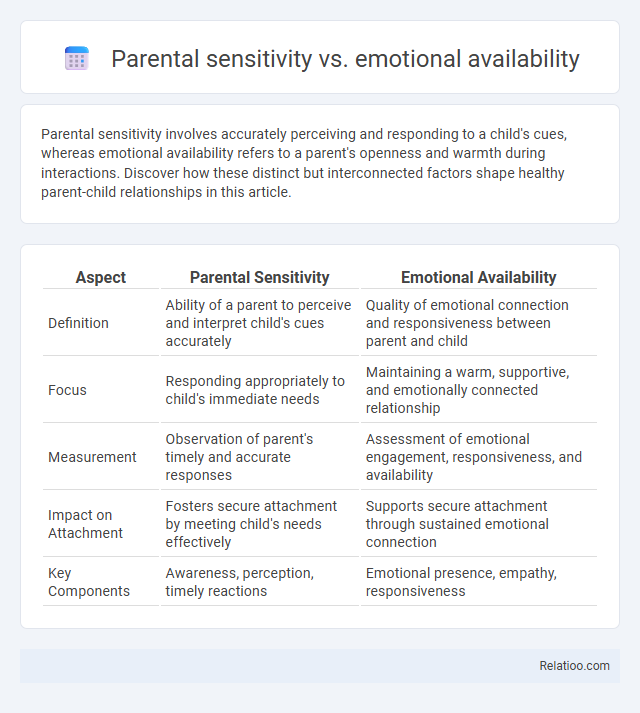Parental sensitivity involves accurately perceiving and responding to a child's cues, whereas emotional availability refers to a parent's openness and warmth during interactions. Discover how these distinct but interconnected factors shape healthy parent-child relationships in this article.
Table of Comparison
| Aspect | Parental Sensitivity | Emotional Availability |
|---|---|---|
| Definition | Ability of a parent to perceive and interpret child's cues accurately | Quality of emotional connection and responsiveness between parent and child |
| Focus | Responding appropriately to child's immediate needs | Maintaining a warm, supportive, and emotionally connected relationship |
| Measurement | Observation of parent's timely and accurate responses | Assessment of emotional engagement, responsiveness, and availability |
| Impact on Attachment | Fosters secure attachment by meeting child's needs effectively | Supports secure attachment through sustained emotional connection |
| Key Components | Awareness, perception, timely reactions | Emotional presence, empathy, responsiveness |
Understanding Parental Sensitivity
Parental sensitivity refers to a caregiver's ability to accurately perceive and respond to their child's emotional and physical needs, fostering secure attachment and healthy development. Emotional availability emphasizes the caregiver's openness, warmth, and responsiveness during interactions, which supports emotional regulation and social growth. Understanding parental sensitivity helps you recognize the critical role it plays in building trust and emotional security between you and your child.
Defining Emotional Availability
Emotional availability refers to a parent's ability to be emotionally present, responsive, and attuned to their child's needs, fostering secure attachment and healthy emotional development. Parental sensitivity emphasizes accurately perceiving and interpreting a child's signals, while emotional availability extends this by ensuring consistent warmth and open communication. Understanding these distinctions helps you create a nurturing environment where your child's emotional expression and bonding thrive.
Key Differences Between Parental Sensitivity and Emotional Availability
Parental sensitivity involves accurately perceiving and responding to your child's cues with appropriate emotional and behavioral reactions, ensuring the child's needs are met promptly. Emotional availability extends beyond sensitivity by emphasizing your openness, warmth, and genuine emotional connection during interactions, fostering a secure attachment. The key difference lies in sensitivity focusing on responsiveness to signals, while emotional availability centers on the quality of emotional engagement and presence.
The Role of Parental Sensitivity in Child Development
Parental sensitivity plays a crucial role in child development by enabling caregivers to accurately perceive and respond to their child's emotional cues, fostering secure attachment and emotional regulation. Emotional availability complements this by emphasizing the quality of the parent-child emotional connection, but parental sensitivity specifically drives the timely and appropriate reactions essential for cognitive and social growth. Your ability to consistently demonstrate parental sensitivity can significantly enhance your child's resilience and interpersonal skills throughout their developmental milestones.
Emotional Availability and Secure Attachment
Emotional availability refers to a parent's ability to be emotionally present, responsive, and attuned to their child's needs, which fosters secure attachment by promoting trust and emotional regulation in the child. Parental sensitivity involves recognizing and accurately interpreting a child's cues, but emotional availability extends beyond this by incorporating warmth, empathy, and genuine connection. Research shows that higher emotional availability is strongly correlated with secure attachment, supporting healthy socio-emotional development and resilience in children.
Measuring Parental Sensitivity and Emotional Availability
Measuring parental sensitivity involves assessing a caregiver's ability to accurately perceive and respond to a child's cues with appropriate and timely reactions, often through observational methods like the Ainsworth Sensitivity Scale. Emotional availability expands on this by evaluating the emotional connection and warmth between parent and child, commonly measured using the Emotional Availability Scales (EAS), which assess dimensions such as parental responsiveness, structuring, and non-hostility. Both constructs are crucial but differ in scope; parental sensitivity focuses specifically on responsiveness to the child's needs, while emotional availability encompasses the broader emotional quality of the parent-child relationship.
Factors Influencing Parental Sensitivity
Parental sensitivity is primarily influenced by factors such as parental stress levels, mental health status, and social support availability, which directly affect a caregiver's ability to accurately perceive and respond to an infant's cues. Emotional availability extends beyond sensitivity by encompassing the parent's ability to express affect and maintain emotional connection, influenced by attachment history and current emotional regulation skills. The dynamic interplay of these factors determines the overall quality of parental responsiveness and the development of secure child attachment patterns.
Enhancing Emotional Availability in Parenting
Enhancing emotional availability in parenting requires recognizing the subtle differences between parental sensitivity and emotional availability, where sensitivity involves accurately perceiving and responding to your child's cues, while emotional availability encompasses being fully present, emotionally connected, and supportive. By improving your emotional responsiveness and maintaining an open, empathetic attitude, you foster secure attachment and promote your child's emotional development. Consistent emotional availability strengthens trust and resilience, which are crucial for your child's overall well-being and social competence.
Impact on Children’s Emotional and Social Outcomes
Parental sensitivity, emotional availability, and responsiveness each play a critical role in shaping children's emotional and social development by fostering secure attachment and healthy self-regulation skills. Your consistent emotional availability helps children develop trust and empathy, while parental sensitivity ensures appropriate recognition and response to children's cues, promoting social competence and emotional resilience. Research highlights that higher levels of these parenting behaviors collectively correlate with better peer relationships, reduced behavioral problems, and improved emotional intelligence in children.
Strategies for Balancing Sensitivity and Emotional Availability
Balancing parental sensitivity and emotional availability requires recognizing your child's emotional cues while maintaining consistent responsiveness to their needs. Effective strategies include practicing active listening, validating your child's feelings without immediate judgment, and creating a safe environment that fosters open emotional expression. By combining sensitivity with emotional availability, you strengthen your bond and support healthy emotional development in your child.

Infographic: Parental sensitivity vs Emotional availability
 relatioo.com
relatioo.com